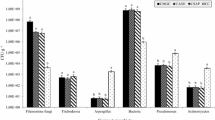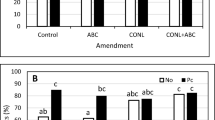Abstract
Composts prepared from mixtures of bagasse + filter mud (BF) and bagasse + vinasses + filter mud (BVF) were evaluated for suppressiveness to Pythium aphanidermatum in climatic chamber experiments. Twenty five-g samples of BF and BVF composts in plastic pots (130 mL) were infested with 1,000 oospores of P. aphanidermatum produced on oat meal agar. After 1, 15, 30 and 45 days, survival of the fungus was estimated by measuring inoculum density. Disease incidence was appraised on cucumber (Cucumis sativus) “Vert Long Anglais” seedlings raised on the composts. Propagules of P. aphanidermatum surviving in the compost after 24 hr was estimated at 22 and 18 cfu g−1 dry wt. potting mix, for BF and BVF, respectively. This population decreased significantly to 6–7 cfu g−1 of compost for the 15–45-d incubation treatment. Seedling mortality was not observed in uninfested controls. In uninfested treatments, 40 and 67% of seedlings died for the 1-d incubation treatment in BVF and BF, respectively; no mortality was recorded thereafter. Heat treatment of the composts revealed that the suppressive effect was biological in nature. Quantitative reduction of micro-organisms occurred in pasteurized composts (55°C for 2 h), compared to the populations in unheated controls. However the greatest decrease was observed for fungal populations. The main fungal species observed in unheated, suppressive composts were Aspergillus sp., Geotrichum sp. and a non-sporulating Pythium. The last two species disappeared in pasteurized, conducive composts.
Similar content being viewed by others
References
Boehm M J and Hoitink H A J 1992 Sustenance of microbial activity in potting mixes and its impact on severity of Pythium root rot of Poinsettia. Phytopathology 82, 259–264.
Chen W, Hoitink H A J and Schmitthenner A F 1987 Factors affecting suppression of Pythium damping-off in container media amended with composts. Phytopathology 77, 755–760.
Elad Y and Chet I 1987 Possible role of competition for nutrients in biocontrol of Pythium damping-off by bacteria. Phytopathology 77, 190–195.
Hadar Y and Mandelbaum R 1986 Suppression of Pythium aphanidermatum damping-off in container media containing composted liquorice roots. Crop Protection 5, 88–92.
Hoitink H A J 1980 Composted bark, a lightweight growth medium. Plant Dis. 64, 142–147.
Hoitink H A J, Nelson E B and Gordon D T 1982 Composted bark controls soil pathogens of plants. Ohio Report 67, 7–10.
Hoitink H A J 1986 Basis for the control of soilborne plant pathogens with composts. Ann. Rev. Phytopathol. 24, 93–114.
Houtondji C A 1986 Etude du Dépérissement du “Chou Caraibe”, Xanthomonas sagittifolium (L) Schott dans les Antilles. Thèse de doctorat de 3e cycle Université de Rennes I, France. 93p.
Lewis J A, Lumsden R D, Millner P D and Keinath A P 1992 Suppression of damping-off peas and cotton in the field with composted sewage sludge. Crop Potection 11, 260–266.
Lumsden R D, Lewis J A and Millner P D 1983 Effect of composted sewage sludge on several soilborne pathogens and disease. Phytopathology 73, 1543–1548.
Lumsden R D, Garcia-E R, Lewis J A and Frias-T G A 1987 Suppression of damping-off caused by Pythium spp. in soil from the indigenous mexican chinampa agricultural system. Soil Biol. Biochem. 19, 501–508.
Mandelbaum R, Hadar Y and Chen Y 1988 Composting of agricultural wastes for their use as container media: Effect of heat treatments on suppression of Pythium aphanidermatum and microbial activities in substrates containing compost. Biol. Wastes 26, 261–274.
Ricci P, Toribio J A and Messiaen C M 1976 La dynamique des populations de Pythium dans les sols marachers de Guadeloupe. Ann. Phytopathol. 8, 51–63.
Schüler C, Biala J, Bruns C, Gottschall R, Ahlers S and Vogtmann H 1989 Suppression of root rot on peas, beans and beetroots caused by Pythium ultimum and Rhizoctonia solani through the amendment of growing media with composted organic household waste. J. Phytopathol. 127, 227–238.
Tahvonen R 1982 The suppressiveness of finnish light coloured sphagnum peat. J. Sci. Agric. Soc. Finl. 54, 345–356.
Theodore M and Toribio J A 1994a Suppression of Sclerotium roifsii and Pythium aphanidermatum by composts of sugarcane factory residues. Caribbean Food Crops Society 34th Annual Meeting, St Thomas USVI, July 31–August 5 1994.
Theodore M and Toribio J A 1994b Behaviour of Sclerotium rolfsii in composts of sugarcane factory residues. Document URPV, INRA Centre Antilles-Guyane.
Theodore M, Toribio J A, Clairon M and Bazile F 1994 Characterisation physique, chimique et biologique de composts de résidus de sucreries de cannes. Agronomie (MXR 389).
Wolffhechel H 1988 The suppressiveness of sphagnum peat to Pythium spp. Acta Hortic. 221, 217–222.
Author information
Authors and Affiliations
Rights and permissions
About this article
Cite this article
Theodore, M., Toribio, J.A. Suppression of Pythium aphanidermatum in composts prepared from sugarcane factory residues. Plant Soil 177, 219–223 (1995). https://doi.org/10.1007/BF00010128
Received:
Accepted:
Issue Date:
DOI: https://doi.org/10.1007/BF00010128




